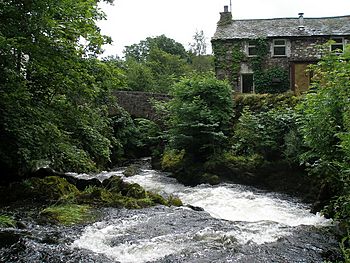River Sprint facts for kids
Quick facts for kids Sprint |
|
|---|---|

The Sprint at Garnett Bridge
|
|
| Country | England |
| Physical characteristics | |
| Main source | Harter Fell |
| River mouth | confluence with River Kent |
The River Sprint is a river located in Cumbria, England. It starts high up on the south side of a mountain called Harter Fell. The river then flows until it joins the River Kent just south of a place called Burneside.
Contents
Journey of the River Sprint
The first part of the River Sprint, about two miles long, has many short flat areas. These flat parts are broken up by amazing waterfalls. After this, the river enters the Longsleddale valley.
Once in Longsleddale, the River Sprint gets wider. This is because many smaller streams, known as becks, flow into it. The word "beck" comes from an old language called Old Norse.
Why Does the River Sprint Flood?
The River Sprint is known as the fastest rising river in England. This means its water level can go up very quickly. Because of this, the river often floods in the Longsleddale valley. When it floods, the road there can become impossible to use.
When there is a lot of water, the river looks very impressive. It is a popular spot for people who enjoy canoeing and fishing.
How People Used the River
For a long time, from the Middle Ages until the 1900s, the River Sprint was used to power mills. These mills were like factories that used the river's energy to do work. There were mills at Garnett Bridge and further downstream at Sprint Mill, near Burneside.
Wildlife and the River's Health
The River Sprint is an important home for a special type of animal called the white clawed crayfish. These crayfish are like small lobsters that live in fresh water. They are a main reason why these rivers are protected as a Special Area of Conservation. This protection helps keep the crayfish safe.
Protecting the River's Water Quality
The water in the River Sprint has had some problems because of damaged peatlands at its source. Peatlands are wet, boggy areas where dead plants build up. The damage to these peatlands is thought to have happened because too many animals grazed there in the past.
To help fix this, the Environment Agency started a project. This project aims to make the water cleaner and help prevent flooding. It is part of a bigger plan called the "Source to Sea Programme." This program works to fix peatlands in areas where rivers flow into Morecambe Bay. One important site is Borrowdale Moss. Water from the bogs there flows into the River Sprint and also into the nearby River Lune.

